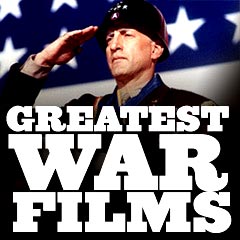
|
Greatest War Movies 2000s |
| Film Title/Year/Director, War-time Setting and Brief Description | ||

|
Tigerland (2000)
This gritty film depicted Advanced Infantry Training at a boot camp in Louisiana for inexperienced Vietnam-bound recruits called Fort Polk, infamously known as Tigerland since it simulated a SE Asian jungle. It portrayed the brutalization of the young trainees in their final week before being shipped overseas, including a stubborn, defiant and rebellious ("smart-alec") Texan named Roland Bozz (Colin Farrell) who was drafted into the Army and opposed the war. During the simulated training (using live ammunition), he proved his leadership abilities, although he continued to maintain his attitude of using his "X-ray eyes for loopholes." |
 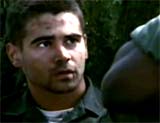
|
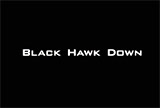
|
Black Hawk Down (2001)
Ridley Scott's suspenseful and compelling war film, based on Mark Bowden's 1999 book, recreated the bloody events surrounding the tragic and ill-fated October 1993 American ground-force siege of the civil war-torn Somalian city of Mogadishu. It told about a failed helicopter mission, when a Black Hawk helicopter (in the elite Delta Force of US Army Rangers) was shot down by a rocket-propelled grenade from Somali militia, resulting in a 15-hour catastrophic firefight with 19 American and countless other Somalian deaths. The action-filled war film was relentlessly exciting and gripping, and won two Oscars for Best Sound and Best Film Editing. |
 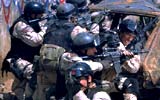
|
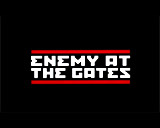
|
Enemy at the Gates (2001)
This war film was based upon William Craig's 1973 nonfiction book Enemy at the Gates, about the siege of Stalingrad (1942-1943) that ended with almost two million casualties, and lasted about six months. German and Russian armies met for battle in the city of Stalingrad, personalized in a cat-and-mouse between two snipers: the Red Army's Vassili Zaitsev (Jude Law), and German Nazi - Major Erwin König (Ed Harris). Both were marksmen with impressive shooting skills. A secondary distracting subplot involved Vassili's romantic rivalry (in a love triangle) with his political-officer friend and newspaperman Commisar Danilov (Joseph Fiennes) over the love of Jewish militia soldier Tania Chernova (Rachel Weisz), who wanted to avenge the murder of her parents by the Nazis. |
 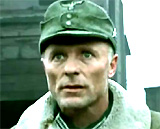 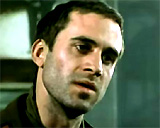
|

|
The Pianist (2002)
Exiled Best Director-winning Roman Polanski's film won a Best Actor Oscar for lead actor Adrien Brody, who portrayed the harrowing ordeal of survival for Jewish-Polish musician Wladyslaw Szpilman (based on his written memoirs) during the years of the Holocaust. When WWII broke out in Poland in 1939 and the Nazis began occupation, his work for a Warsaw radio station ended abruptly and the rights of tormented Polish Jews rapidly deteriorated as they were systematically exterminated. He witnessed the atrocities while in hiding in various buildings and apartments, including the put-down of the Warsaw Ghetto uprising in 1943. In the film's most memorable scene set in bombed out Warsaw buildings in the war's later years, a chance encounter with a sympathetic German Army Captain Wilm Hosenfeld (Thomas Kretschmann) led to his grand piano rendition of Chopin's Ballad in G Minor for the Nazi leader - who then helped him to survive the final days of the war. |
 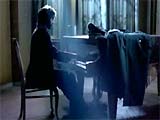 
|
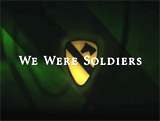
|
We Were Soldiers (2002)
Randall Wallace's factual tribute film and war-time character study starred Mel Gibson as inspiring Lieut. Colonel Hal Moore. The war film was based on the book We Were Soldiers Once...And Young by Lieutenant General (Ret.) Hal Moore and reporter Joseph L. Galloway. It began with the words: "These are the true events of November, 1965..." to chronicle the US' first major bloody, heroic engagement (part of the Pleiku Campaign) between 450 American troops in the First Battalion, Seventh Cavalry regiment and well-armed 2,000 N. Vietnamese regulars in the People's Army (NVA) in late 1965 at the Battle of Landing Zone X-Ray (in the Ia Drang Valley). The conflict was in an area to be called The Valley of Death in South Vietnam's Central Highlands. The film both emphasized the toll of war on the battlefront and on the homefront, and in its conclusion emphasized how Moore kept his vow to his men in a speech delivered in an outdoor high school football stadium: "That when we go into battle, I will be the first to set foot on the field, and I will be the last to step off. And I will leave no one behind. Dead or alive, we will all come home together. So help me God." |
 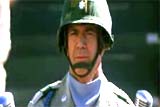
|

|
Downfall (2004, Germ.) (aka Der Untergang)
This realistic German war film was told from the perspective of one of Adolf Hitler's personal secretaries, Traudl Junge (Alexandra Maria Lara). (She appeared as Herself in opening and closing documentary scenes.) It depicted the last few chaotic days within Hitler's (Bruno Ganz) underground Nazi bunker as the Allied troops advanced on Berlin. Downfall was the first German-speaking Hitler to be portrayed seriously since Nazism was censored in post-war Germany. The claustrophic, tension-filled last days showed the Fuhrer descending and disintegrating into madness and losing touch with reality as he moved fictional military divisions around on a map, and frequently burst into anger. His inner circle, including Joseph and Magda Goebbels (Ulrich Matthes and Corinna Harfouch) in one harrowing scene, first poisoned their six children before committing suicide. Outside the bunker, SS doctor Ernst-Günther Schenck (Christian Berkel) encountered the despairing chaos of a disintegrating Berlin as children were forced to suicidally fight encroaching Allied forces and elderly German citizens were executed for refusing to keep fighting the doomed battle. The conclusion featured Junge and young Hitler Youth soldier Peter Kranz (Donevan Gunia) slowly, peacefully walking through Russian troops to safety. |
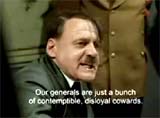 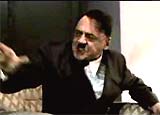
|
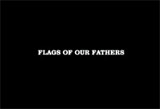
|
Flags of Our Fathers (2006)
Clint Eastwood directed two films (released in a 3-month period) based on the pivotal WWII battle over the island of Iwo Jima. This first one was his 26th directed film. (See Eastwood's second film below) It was adapted from the co-authored James Bradley and Ron Powers' non-fictional book Flags of Our Fathers: Heroes of Iwo Jima. The story provided details surrounding the iconic and familiar Pulitzer Prize-winning photograph by Joe Rosenthal on Mount Suribachi called Raising the Flag at Iwo Jima. The film told of the bloody engagement to take control of the Pacific island from the Japanese, with at least 6,000 Americans dying in the month-long conflict, and the propagandistic efforts of the US media to bolster morale by capitalizing on the three Iwo Jima flag-raisers who survived. |
 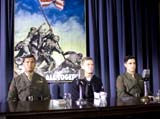
|
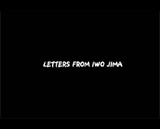
|
Letters From
Iwo Jima (2006) (aka Iōjima Kara No Tegami)
This was Eastwood's contemplative, bleak second film (See Flags of Our Fathers (2006), Eastwood's first film) which examined the same nihilistic battle from the Japanese perspective. This bookend film, with Japanese dialogue (requiring subtitles) starred Ken Watanabe as Japanese commander Lt. Gen. Tadamichi Kuribayashi who led the enemy's troops, and who sent letters to his family - the basis for the film. The complex character study was filmed with desaturated, washed-out color to give it authenticity. |
 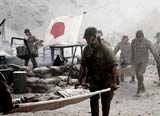
|
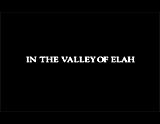
|
In the Valley of Elah
(2007)
The film's title referred to the location where David slew the mighty Goliath. The famed Biblical tale served as an allegory for the blood-soaked, dehumanizing Iraqi war involving US soldiers fighting the enemy in impossible situations and witnessing atrocities that often led to PTSD. The psychological drama was partly based upon reporter Mark Boal's 2004 story first published in Playboy Magazine. In the story (not a true war film but a crime drama-thriller), retired Vietnam vet and military cop Hank Deerfield (Tommy Lee Jones) sought answers from the US Army about his son Mike's (Jonathan Tucker) disappearance and death -- not on the battlefield in Bagdad, Iraq, but at his Fort Rudd Army base and barracks in New Mexico, after returning home on leave. Mike's body was soon found dismembered and burned, and Mike's AWOL suddenly became a murder investigation. Hank had left his Monroe, Tennessee home and grieving wife Joan (Susan Sarandon), drove westward, and began his own intensive personal investigation, solely supported by tough-talking civilian New Mexico police officer and single mother Det. Emily Sanders (Charlize Theron). He was only stonewalled or told lies when he confronted military officers, including Lt. Kirklander (Jason Patric), and Mike's own group of soldiers: Corporal Steve Penning (Wes Chatham), Spc. Ennis Long (Mehcad Brooks), Private Robert Ortiez (Victor Wolf), and Spc. Gordon Bonner (Jake McLaughlin). Deerfield was able to uncover disturbing evidence in his son's own home-made, grainy and jerky cell phone video recordings made in Iraq. The wartime event that traumatized Mike, driving in the lead vehicle in a convoy, was when he was forced to not stop and run over a young boy in the road. To escape and deal with the stress, Mike had resorted to alcohol, drugs, and stripclubs. Eventually, Hank learned that Mike's own comrade, Cpl. Penning had gotten into an altercation with Mike in a strip club, and later killed him during a drunken knife fight (there were 42 stab wounds) in a field. Spc. Bonner (an ex-butcher) had dismembered the body before it was burned (and then committed suicide). A cover-up regarding Mike's forged signature on a credit card restaurant receipt for a chicken dinner following the murder was the key to solving the case. |
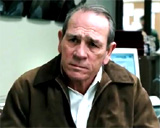 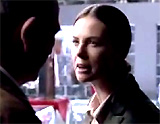 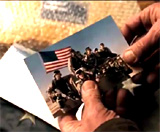 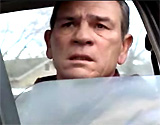
|
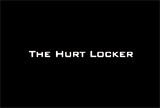
|
The Hurt Locker (2009)
One of the best and most tense war films in quite a few years, this one was based upon the actual experiences of journalist and Oscar-winning screenwriter/producer Mark Boal. It was also an historic, notable Best Picture win for Bigelow, the first female Best Director winner. The fact-based but fictional character study and action-thriller was about Army Staff Sergeant William James (Jeremy Renner) and his elite team of expert bomb-defusers (Army EOD- Explosive Ordnance Disposal squad), faced with sniper fire and the dangerous detonation of IED bombs during their time in Baghdad. |
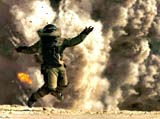 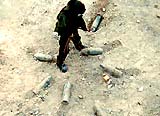
|
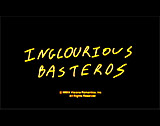
|
Inglourious Basterds
(2009)
Writer/director Tarantino's epic war-time drama (divided into five chapters) was a World War II fantasy/comedy. It told about flamboyant Tennessee-born American Lt. Aldo "The Apache" Raine (Brad Pitt) and his guerrilla troupe of Jewish-American soldiers known as the Basterds, from whom he demanded 100 scalps each, and whose goal was to sabotage Nazi installations behind enemy lines, assassinate political leaders, and end the Third Reich. Raine's group joined German actress and traitorous undercover agent Bridget von Hammersmark (Diane Kruger) on a similar mission Austrian actor Christoph Waltz starred as diabolical, over-the-top, seductively-charming, villainous "Jew hunter" and quadri-lingual Nazi SS Colonel Hans Landa. In the opening scene, Landa deftly interrogated French dairy farmer Perrier La Padite, who reluctantly admitted that the doomed Jewish Dreyfus family was hiding under the floorboards. [Note: Jewish girl Shosanna Dreyfus (Mélanie Laurent) was the sole survivor who escaped and would later take the name Emmanuelle Mimieux, and serve as the pretty owner-operator of a Paris film theatre where the ultimate deadly revenge would occur against the Nazis.] In the film's climax set at a Parisian theatrical venue where a Nazi propaganda film, Stolz der Nation (Nation's Pride) was to be premiered, the Basterds planned to attack and kill the Nazi leaders in attendance. During the screening, the cinema was set ablaze with Hitler (Martin Wuttke) and Goebbels inside, and everyone perished from machine-gun fire. In the conclusion, Landa was traded to the Allies in a deal to give him immunity, but not before Raine carved a swastika symbol into his forehead, and then boasted to Private Utivich (B.J. Novak): "You know somethin', Utivich? I think this just might be my masterpiece!" |
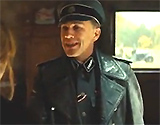 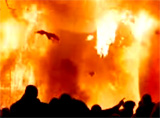 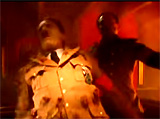 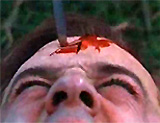 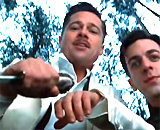
|
(chronological by film title) Introduction | 1900s-1920s | 1930s | 1940s-1 | 1940s-2 | 1950s | 1960s-1 | 1960s-2 | 1970s | 1980s | 1990s | 2000s | 2010s | 2020s |